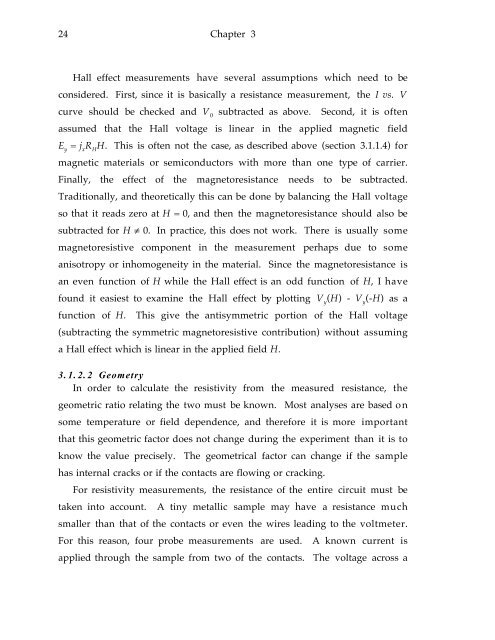MAGNETISM ELECTRON TRANSPORT MAGNETORESISTIVE LANTHANUM CALCIUM MANGANITE
MAGNETISM ELECTRON TRANSPORT MAGNETORESISTIVE LANTHANUM CALCIUM MANGANITE
MAGNETISM ELECTRON TRANSPORT MAGNETORESISTIVE LANTHANUM CALCIUM MANGANITE
You also want an ePaper? Increase the reach of your titles
YUMPU automatically turns print PDFs into web optimized ePapers that Google loves.
24 Chapter 3<br />
Hall effect measurements have several assumptions which need to be<br />
considered. First, since it is basically a resistance measurement, the I vs. V<br />
curve should be checked and V 0 subtracted as above. Second, it is often<br />
assumed that the Hall voltage is linear in the applied magnetic field<br />
E y = j x R H H. This is often not the case, as described above (section 3.1.1.4) for<br />
magnetic materials or semiconductors with more than one type of carrier.<br />
Finally, the effect of the magnetoresistance needs to be subtracted.<br />
Traditionally, and theoretically this can be done by balancing the Hall voltage<br />
so that it reads zero at H = 0, and then the magnetoresistance should also be<br />
subtracted for H ≠ 0. In practice, this does not work. There is usually some<br />
magnetoresistive component in the measurement perhaps due to some<br />
anisotropy or inhomogeneity in the material. Since the magnetoresistance is<br />
an even function of H while the Hall effect is an odd function of H, I have<br />
found it easiest to examine the Hall effect by plotting V y (H) - V y (-H) as a<br />
function of H. This give the antisymmetric portion of the Hall voltage<br />
(subtracting the symmetric magnetoresistive contribution) without assuming<br />
a Hall effect which is linear in the applied field H.<br />
3.1.2.2 Geometry<br />
In order to calculate the resistivity from the measured resistance, the<br />
geometric ratio relating the two must be known. Most analyses are based o n<br />
some temperature or field dependence, and therefore it is more important<br />
that this geometric factor does not change during the experiment than it is to<br />
know the value precisely. The geometrical factor can change if the sample<br />
has internal cracks or if the contacts are flowing or cracking.<br />
For resistivity measurements, the resistance of the entire circuit must be<br />
taken into account. A tiny metallic sample may have a resistance much<br />
smaller than that of the contacts or even the wires leading to the voltmeter.<br />
For this reason, four probe measurements are used. A known current is<br />
applied through the sample from two of the contacts. The voltage across a
















